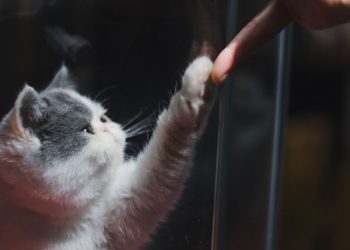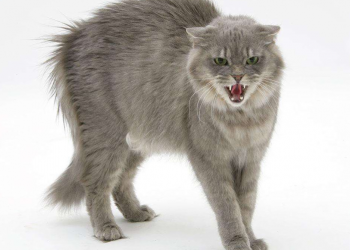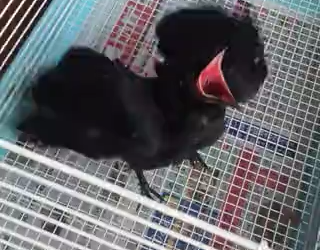A beloved pet is an extension of the family, and to many pet parents, there’s no greater pleasure than cuddling up with a furry friend on the sofa. Pet owners are accustomed to dealing with fur balls, scratches, and the occasional accident or muddy paw print, but a bit of preparation when shopping for a sofa can help you avoid headaches and possible furniture damage. And if you already have a couch you love, don’t worry! The right techniques will help you pet-proof the piece to make sure it lasts for many snuggle sessions to come.
Related: 10 Pet Furniture Ideas That Will Fit Seamlessly in Any Home
cat sitting on leather couch
Pet-Proof Sofa Materials
According to pet and furniture experts, the best fabrics to look for when shopping for a new sofa are ones that are scratch-resistant, stain-resistant, and won’t trap hair.
Leather
One of the biggest perks of having a leather couch in your home? Pet hair won’t cling to it. “Pet hair doesn’t stick to these materials, and they can easily be wiped down if there is any fur sitting on them or your pets get it dirty,” says Janet Cutler, Ph.D., a certified cat behaviorist at Cat World. Plus, leather is a durable material that is less likely to get damaged from your pets’ claws. Do mind the color of material, though, as some scratches could appear on new leather or faux leather. Once the material ages, the marks will be much less visible, adds Cutler.
Another reason to shop for a leather or faux leather sofa? Julie Burgess, CPDT-KA, a certified dog trainer at SeniorTailWaggers.com, says the material is resistant to accidents, so you can wipe away liquid splotches without damaging the couch’s natural finish or texture.
Microfiber
“Pet hair doesn’t stick well to microfiber, and can be easily brushed or vacuumed off,” says Cutler. “Depending on the color, dirt or scratches could be visible, so keeping that in mind if you have pets could be important, however, this fabric is usually pretty easy to spot clean and is quite resistant to punctures or rips.” Burgess adds that this option is ideal for people with allergies since the tightly woven material is less likely to accumulate pet dander.
Denim
While you may be used to denim clothing, a couch made with this fabric is a helpful choice when trying to maintain furniture’s quality with pets around. “Punctures, tears, or unraveling fabric is unlikely due to its tightly woven characteristics,” says Burgess. “You can’t beat denim for its softness when you want to cuddle with your pet because it gets cozier as the fabric ages.” To care for this material, the pet expert says you can simply vacuum up pet hair, dirt, and other debris, while using mild soap and water on a stain to get rid of it.
Canvas
If you are in search of another couch fabric that resists pet hair, canvas is a helpful choice because of the tightly woven fibers that prevent dirt and hair getting trapped. This material also repels foul smells, Burgess says, so pets won’t leave any odors behind.
“Performance” Fabrics
Fabrics often used on outdoor furniture are usually called “performance” materials since they can weather the elements of the different seasons—even preventing mold and mildew growth. Cutler says the tight weaves and strong builds of materials like acrylics, olefin, and polyester make them resistant to pet damage, especially during training.
Related: Your Guide to Choosing the Right Size Couch for Your Space
Beautiful devon rex cat laying on hammock and chilling
Short-Term Pet-Proofing Techniques
When it comes to making a sofa pet-proof, Cutler says that protecting the sofa is the quickest method, as opposed to training your pet. “Ideally, protecting the sofa is a short-term solution as you teach your pet not to damage it,” she says.
Use Slip Covers
“This is a great solution to use while training your pet, but also as a longer term solution if your sofa is a fabric or color that could be accidentally damaged by your pet,” Cutler says. “You can put a slipcover over the entire sofa, or put a blanket on an end that you would like your pet to stay on.”
You also want to monitor your pets’ habits to determine where they get the most comfortable. “Cats have a habit of sitting on the back or arms of a sofa (these are also the areas that they’re keener on scratching), so pay special attention to covering those,” says Kinga Wojciechowska, the general assistant manager at Moe’s Home flagship in Vancouver. “It’s essential to make sure the pet has a comfy bed of their own to lounge on.” Consider shopping pet-specific covers, since these are often waterproof.
Fabric Protectants and Deterrents
Consider using an all-natural spray on a sofa that you may not want a pet to touch. “Use a citrus spray, or place some citrus skin around sides, back, and arms of a sofa,” Wojciechowska says. “Cats are not very fond of citrus, so this can be a great deterrent.” You can even check with a local upholstery cleaner, she says, as some have a Scotchgard treatment they can apply on your sofa to make its fabric more durable to spills and pet accidents.
Pet Furniture
When your pet has its own belongings, it’s less likely that they will jump on your sofa. Cutler suggests giving them their own bed in the same room and encouraging them to use it. Wojciechowska adds that having a scratching post and toys nearby can also give them a subtle push to use those items for their own disposal.
Regular Grooming
Tending to your pets’ overall hygiene will inadvertently also help with the maintenance of your couches. “Just like for us, regular baths and grooming will keep your pets in tip-top shape, smelling good, and keep shedding to a minimum,” Burgess says, which can also include keeping their nails trimmed, which prevents tears. “The added benefit to regular grooming is being able to spend quality time with your pet while keeping tabs on their skin, fur, and overall body condition.”
pet gift guide oden treat toy up dog treats
CREDIT: COURTESY OF UP DOG TOYS
Long-Term Pet-Proofing Techniques
If your preference is to train pets to stay off of furniture altogether, it takes time. “If your pet gets up on the furniture, simply remove them,” Cutler says. “Any time they lie down in that room in an appropriate place (such as their own bed, the carpet, or a cat tree), reward them with treats, praise, or play.”
Prevent Cat Scratching
“Scratching is a very normal behavior for cats, so making sure that they have other places to scratch is really important,” Cutler says. “You can also reward your cat for using a scratching post to encourage them to use it.”
Prevent Dog Chewing
Since chewing is a natural behavior for puppies and dogs on a couch (cats are less prone to this behavior on furniture), Cutler recommends training your canines by giving them other things to chew on. “There are many chew toys and chews available, and having these in the same room and rewarding their use with treats or praise can help to decrease the chance they’ll chew on furniture,” she says.
Don’t Use Punishment
Lastly, Cutler says to avoid using any punishment during this pet-proofing and training process, as it could cause fear and give your pet anxiety. “Your pet may also learn that they can’t be on the furniture when you’re around as they risk getting punished, but will hop on when you aren’t around,” she says.




















